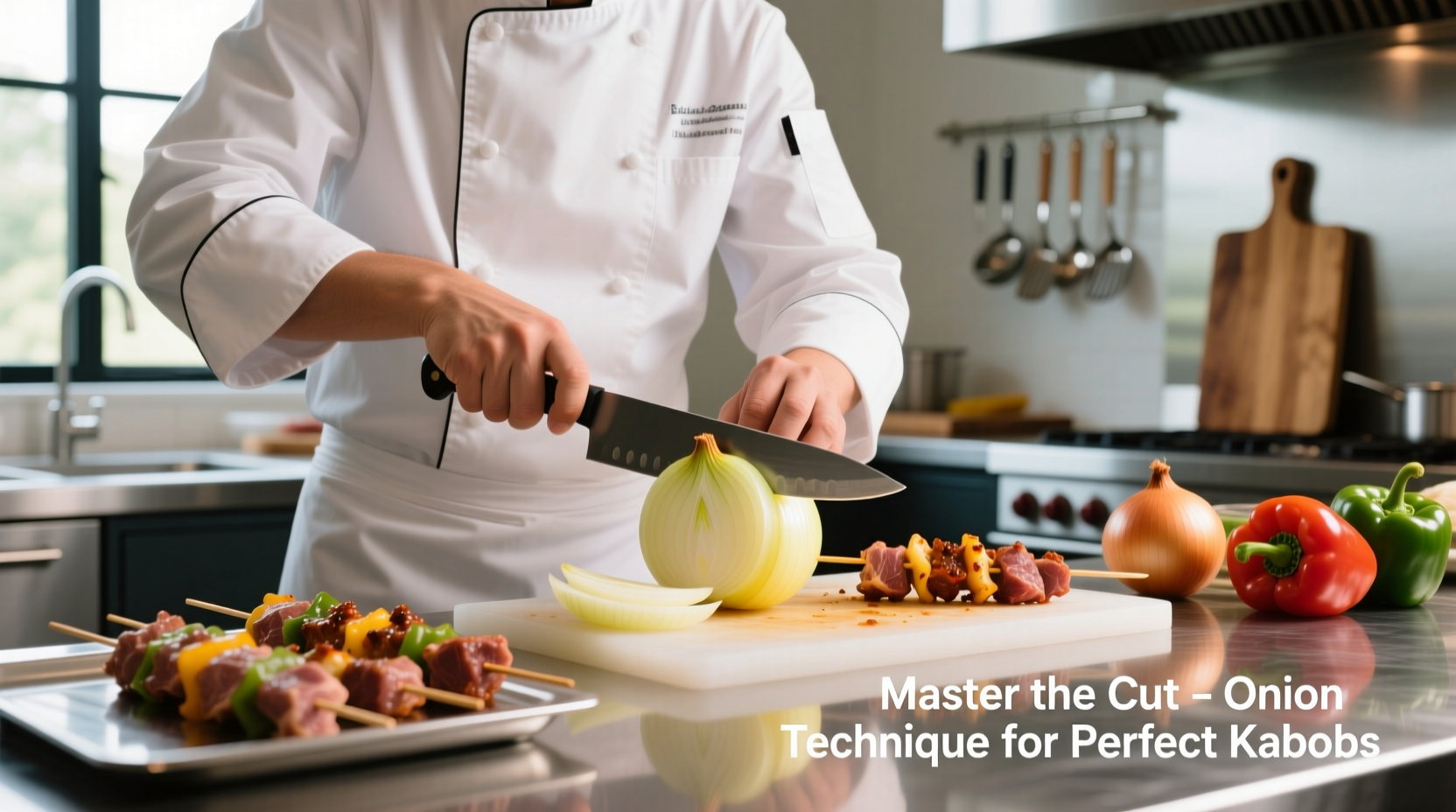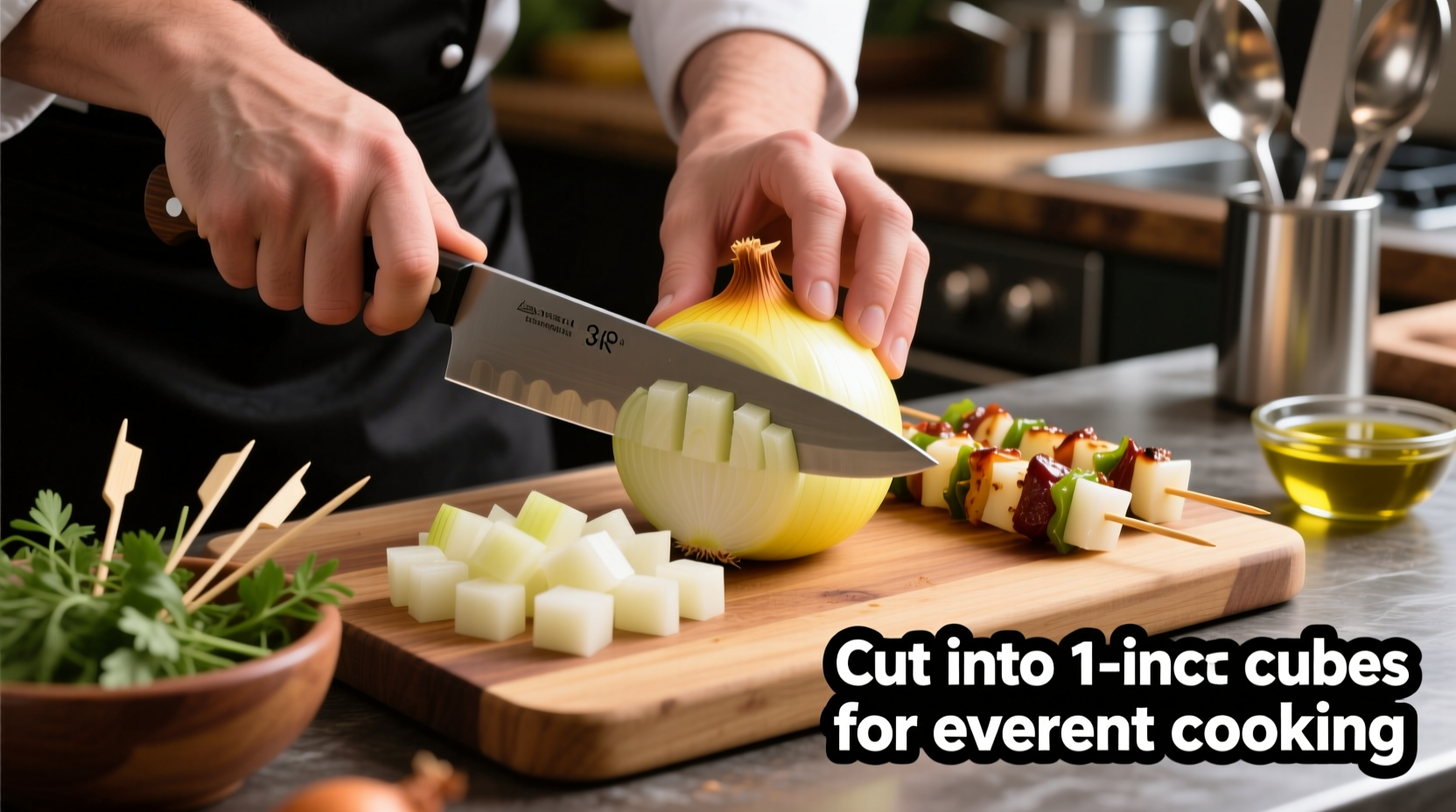Why Onion Cutting Technique Matters for Kabobs
Getting your onion pieces right isn't just about appearance—it directly impacts your kabobs' success. Improperly cut onions either fall through grill grates, cook unevenly, or disintegrate during cooking. Professional grill masters consistently use the 1-1.5 inch cube method because it creates stable pieces that maintain shape while allowing proper heat circulation for even caramelization.
Your Step-by-Step Guide to Perfect Kabob Onions
1. Selecting the Right Onion Variety
Not all onions work equally well for kabobs. Sweet onions like Vidalia or Walla Walla provide milder flavor that won't overpower other ingredients, while red onions offer vibrant color and slightly sharper taste. Yellow onions deliver classic grilled onion flavor with excellent caramelization properties.
| Onion Type | Best For | Texture After Grilling |
|---|---|---|
| Sweet Onions | Milder kabob profiles | Soft, caramelized edges |
| Red Onions | Color contrast, Mediterranean styles | Firm with slight bite |
| Yellow Onions | Traditional kabob flavor | Rich caramelization, balanced texture |
2. Preparation: Setting Up for Success
Before cutting, chill your onion in the refrigerator for 30 minutes—this reduces the volatile compounds that make you cry. Use a sharp chef's knife (dull blades crush cells, releasing more irritants) and work on a stable cutting board. Position yourself near a running fan or open window to direct fumes away from your face.
3. The Professional Cutting Technique
Follow these precise steps for kabob-ready onion pieces:
- Trim both ends of the onion but leave the root end intact—this is crucial for maintaining structure
- Peel away outer layers until you reach clean, firm onion
- Stand onion on root end and make vertical cuts parallel to the root (about 1 inch apart)
- Rotate 90 degrees and make similar cuts perpendicular to first set
- Cut horizontally across to create uniform 1-1.5 inch cubes
- Separate cubes gently, keeping root fibers intact where possible

4. Skewering Your Onion Pieces
Thread onions onto skewers through the flat sides rather than the cut surfaces. This prevents pieces from spinning and ensures maximum surface area faces the heat. Alternate with other ingredients, leaving small gaps between pieces for even cooking. If using wooden skewers, soak them in water for 30 minutes first to prevent burning.
Common Mistakes That Ruin Kabob Onions
Avoid these frequent errors that lead to disappointing results:
- Cutting against the grain—slicing perpendicular to the root end causes pieces to fall apart
- Incorrect size—pieces smaller than 1 inch fall through grill grates; larger than 1.5 inches cook unevenly
- Removing the root completely—without this structural anchor, onions disintegrate during cooking
- Overcrowding skewers—leaves insufficient space for heat circulation around each piece
Pro Tips for Perfect Kabob Onions Every Time
These professional techniques elevate your onion preparation:
- Par-cook for delicate recipes: Briefly blanch onions in boiling water for 30 seconds when pairing with quick-cooking proteins like shrimp
- Oil before skewering: Toss onion pieces in olive oil and seasonings before assembling to prevent sticking and enhance flavor
- Use double skewers for stability—this professional trick prevents rotation when turning on the grill
- Grill placement matters: Position onions away from direct flame initially to prevent burning before proteins cook through
When This Technique Works Best (and Limitations)
This cutting method delivers optimal results for traditional meat and vegetable kabobs cooked on gas or charcoal grills at medium-high heat (375-400°F). It's less effective for:
- Indoor grill pans with small surface holes
- Very high-heat searing applications (above 450°F)
- Recipes requiring completely soft, melted onions
- Using exceptionally large or small onion varieties
Frequently Asked Questions
Can I use a food processor to cut onions for kabobs?
While convenient, food processors create uneven pieces with damaged cell structure that fall apart on the grill. Hand-cutting preserves the onion's natural fibers for better structural integrity.
How far in advance can I cut onions for kabobs?
For best results, cut no more than 2 hours before grilling. Store in a sealed container with a damp paper towel to maintain moisture without becoming soggy.
Why do my onion pieces always burn before meat cooks?
This happens when onions are placed directly over intense heat. Position kabobs with onions slightly elevated or rotate frequently during the first few minutes until a protective char forms.











 浙公网安备
33010002000092号
浙公网安备
33010002000092号 浙B2-20120091-4
浙B2-20120091-4